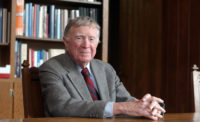Jewish-Serbian architect Greta Ferušić—the only known person to have survived both Auschwitz and the Siege of Sarajevo—died in January this year in Sarajevo, Bosnia, at the age of 97. Though her work isn't widely known in the US, she was an architectural pioneer in Bosnia and the first woman to teach at the University of Sarajevo’s architecture school, where she eventually became dean.
Born Greta Weinfeld in the Yugoslavian city of Novi Sad in 1924, Ferušić was the only child of a prosperous Jewish businessman and his wife. In the 1997 documentary Greta, which chronicled her life story, she described her childhood as idyllic and carefree: “Every luxury was available to me,” she said, lovingly describing the “well-planned” home her family had built in 1935.
In the spring of 1944, the Nazis rounded up the remaining Jews in Novi Sad, including Ferušić and her family, and sent them to Auschwitz-Birkenau. Immediately separated from her family, the nineteen-year-old never saw her parents, aunts, uncles, or grandparents again. She remained imprisoned there until January 1945, when the Soviet army liberated the camp’s inhabitants.
After her liberation from Auschwitz, Ferušić returned to her home city in Serbia. “It was better to think of the future and what could be done with it than to mourn for what had been and for what was lost,” she said in the 1997 film. “I was young and it was logical that my eyes turned to the future and not to the past.” Ferušić sold her family home and in December of 1945, less than a year after her liberation, she enrolled at the Faculty of Architecture at the University of Belgrade. Once a naturally gifted student, she struggled in her first year, saying that her time in camp had severely damaged her memory. But by the end of her first term, she passed a notoriously difficult mathematics exam—of the 440 students in her program, only 40 had elected to take the test and just 10 passed.
In school, she met her future husband Seid Ferušić, a Bosnian Muslim and classmate. The couple married in 1948 and eventually settled in Sarajevo, then a prosperous city known informally as “the Jerusalem of Europe.” Seid found work as a civil engineer and in 1952, Ferušić began teaching at the University of Sarajevo’s architecture school. She was appointed vice-dean of the university’s Architecture Faculty in 1970, and dean in 1972.
“I always enjoyed teaching, and I took great care to present as clearly as possible matters that are, for architects—I will not say difficult—but unpleasant,” she said. A technical specialist, she noted that “architects never enjoy the construction aspects of their projects; they like to leave them to someone else. But they are very important for an architect’s general knowledge.”
Nearly 50 years after being torn from her childhood home and her family in Serbia, Ferušić’s life was once again upended by war in 1992, when the Yugoslav People’s Army surrounded Sarajevo. While many of her neighbors and friends fled (including her son, his wife, and their small children), Ferušić refused to be forced from her home once again. “I belong to this city,” she said of her mindset at the time. “Let the fate of the city and its inhabitants also be my fate.”
For the next four years, Sarajevo endured constant bombardment, first by the People’s Army and then by the Bosnian Serb Army. The Ferušićs stayed in the city even after a tank shell fell on their apartment; she and her husband sheltered in their bathroom while the ceiling of their living room collapsed. “Before, I always felt safe at home, even though terrible things happened outside,” she said of the event. “That whole feeling of security was disturbed.” By the final 1995 cease-fire, over 11,000 people had been killed—including over 5,000 civilians.
“It was another genocide,” said Ferušić. “The only fault of the Bosnians was that they were Bosnians, just as the only fault of the Jews was that we were Jews. For another time in my life, I was not in control of my own destiny. I was an instrument in someone else’s hands.”
Haris Pasovic, the Bosnian director who made the 1997 documentary and a fellow survivor of the siege, told the New York Times that he believes Ferušić became an architect because she had witnessed so much destruction and wanted to build things instead. Today her family continues that legacy. Her son, Edgar, his wife and their two sons are all architects, and one of her grandsons, Relja Ferušić, is a founding partner at the Barcelona-based firm Sala Ferušić.





